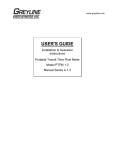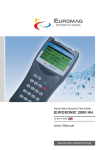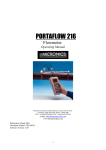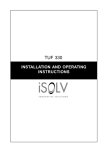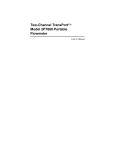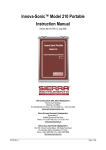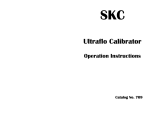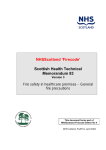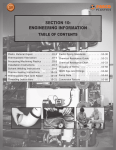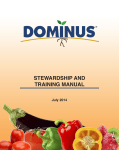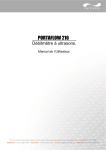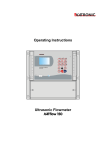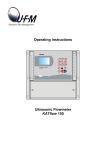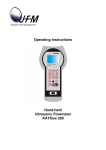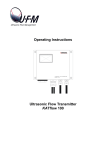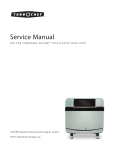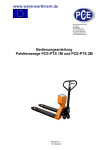Download ULTRAFLO 2000 FLOW & HEATMETER Operating
Transcript
ULTRAFLO 2000 INSTALLATION & OPERATING INSTRUCTIONS ULTRAFLO 2000 FLOW & HEATMETER Operating Manual Micronics Ltd, Knaves Beech Business Centre, Davies Way, Loudwater, High Wycombe, Bucks. ENGLAND. HP10 9QR TEL: +44 (0)1628 810456 FAX: +44 (0)1628 531540 e-mail: [email protected] www.micronicsltd.co.uk 1 ULTRAFLO 2000 INSTALLATION & OPERATING INSTRUCTIONS CONTENTS SYSTEM IDENTIFICATION 3 INTRODUCTION 4 HARDWARE Electronics Housing Transducers Transducer Connections Transducer Hardware Transducer Mounting Transducer Cables Keypad 4 4 4 5 5 6 6 MAIN MENU Power up Quick Start View/Edit Site Data Set-up Sensors Calibrate 4-20mA Read Flow 7 8 10 11 12 12 FUNCTIONS Display Set-up 4-20mA Pulses/Set Point CutOff M/S Set Zero Flow Reset Total Flow Reset Total Energy Damping Cal Factor Diagnostics Save And Exit 13 13 14 15 15 15 15 15 16 16 16 ERROR MESSAGES E1:High Flow E2:No Flow Sig E3:Hot Fault E4:Cold Fault 16 16 16 16 WARNING MESSAGES W1:Check Data W2:Timing Poor W3:Signals Poor W4:Ma (1) OVER W5:Ma (2) OVER W6:Pulse At Max 16 16 16 16 16 17 APPLICATION INFORMATION Application Notes Select a Metering Position Mounting The Transducers Liquid Conditions Propagation Velocity Maximum Flow Application Temperature Flow Range Liquid Sound Sppeds Solid Sound Speeds 17 17 18 19 19 19 19 19 20 24 SPECIFICATION 25 HEATMETER INSTRUCTIONS 26 CE MARKING Guidance Notes 27 WARRANTY 27 PRODUCT CARE AND MAINTENANCE 28 WARNING - users should ensure or note that: a) The Ultraflo 2000 is not certified for use in hazardous areas. b) The local site safety regulations are complied with. c) Work is carried out in accordance with The Health & Safety at Work Act 1974. 2 ULTRAFLO 2000 INSTALLATION & OPERATING INSTRUCTIONS FIGURE 1 - SYSTEM IDENTIFICATION FLOW SENSORS ASSEMBLY UP DOWN Figure 1 FLOW RELAY OR PULSE OUTPUT ULTRAFLO 2000 4-20mA(1) OUTPUT MICRONICS F u s 24VDC IN 4-20mA(2) OUTPUT PT100 TEMPERATURE SENSORS please see page 29 (if supplied) F u RETURN The following information is required by Micronics when placing an order. EXAMPLE POWER VOLTAGE................................ 24v DC PIPE OD............................................... 60 PIPE MATERIAL ................................... STEEL APPLICATION TEMP............................ 60°C LIQUID ................................................ WATER TRANSDUCER CABLE LENGTH......... 50 METRES MAX FLOW IN UNITS........................... 150L/MIN MAX ENERGY RATE (HEATMETER ONLY) .......................1000KW TEMPERATURE DIFFERENTIAL (HEATMETER ONLY)........................... 25°C TEMPERATURE PROBE CABLE LENGTH (HEATMETER ONLY)............ 50 METRES Example Order Code 24-60-S-60-W-50-150L/min 3 110/240V SUPPLY ULTRAFLO 2000 INSTALLATION & OPERATING INSTRUCTIONS The Ultraflo 2000 is a “Clamp-on” liquid flow meter that uses the Transit Time method of measurement to read flow. Using two PT100 temperature probes to measure temperature it can also be used as a Heat/Energy meter. Having completed the procedure for mounting the electronics, connecting all cables and checking the power supply, the power can now be applied. The Ultraflo 2000 is now ready for programming. A full programming procedure is described on page 7. The Ultraflo is able to measure the flow of liquid in any pipe from 13mm to 5000mm, providing the pipe is flooded and the correct transducers are used. Units are supplied according to application data provided by the customer. Before programming the instrument, it is necessary to attach the transducers to the pipe wall such that they can be finally locked in the correct position based on exact data provided by the instrument. The instrument displays volumetric flow rate in 3 3 3 m /hr, m /min, m /sec, g/min, USg/hr, l/min, l/sec and linear velocity in metres and feet per second. The total volume of flow will be displayed, up to a maximum 12-digit number. When supplied as a Heatmeter, kW, kCal/hr, MJ/hr, MJ/min and MJ/sec can be displayed, as well as the temperature differential. TRANSDUCERS Each instrument uses two identical transducers, which transmit and receive the ultrasonic waves. They are clamped to the pipe surface using the mounting hardware supplied, as described on pages 5, 6. INTRODUCTION The standard transducers are made from a Peek material with an aluminium plate supporting the stud, used to lock the sensor in position. A flying armoured lead is attached between the sensor block and the tuning circuit. The flowmeter is supplied with electronics, sensors and all mounting hardware. The Heatmeter version will also be supplied with PT100 temperature probes. Figure 3 – 1MHz Sensors with TNC Coaxial Connector HARDWARE Electronics Housing An ABS housing with an opaque door contains the master PCB. The housing is designed for wall mounting using the brackets provided (see Figure 2 for mounting pattern). Drilling further fixing holes in the Housing remove the IP67 protection rating and CE approval. Mounting the housing into position does not require the removal of the electronics or the front display panel. Figure 2 Transducers are supplied according to the pipe size and flow velocity, and are available to meet an operating temperature range from –20°C up to +200°C. Transducer Connections Transducers are connected to the electronics from the tuning circuit by TNC connectors. All other output and input connections are made through metal glands to the clearly marked terminals. DO NOT PROVIDE POWER to the instrument until the service compartment cover has been replaced. 24V 1 2 3 4 5 6 7 8 9 10 11 12 13 + - + - + - + + - + NC COM NO MA1 MA2 The electronics are factory set for a particular supply voltage. Should it be necessary to change the settings for the power supply see page 7, Power up. HOT COLD RELAY Coax sensor connectors Coax cable 4 220VAC 14 15 F U S E + 24VDC 110VAC F U S E 16 17 18 L N E AC IN ULTRAFLO 2000 INSTALLATION & OPERATING INSTRUCTIONS Only one current output can be used with the flow meter. The heatmeter option is supplied with a separate heat integrator, please see page 29. PT100 temperature probes should be connected to the supplied integrator, please see page 29. Before attempting to attach the transducers it is imperative to ensure that the correct position has been chosen to site the transducers and that the pipe surface conditions are suitable. Go to page 17 and carefully follow all instructions for the selecting and preparing the transducer mounting site. Transducer Hardware Transducer alignment guide rails, chains and couplant are supplied with all units in order to ensure that the transducers are accurately aligned with respect to the pipe axis. At this point program the instrument to determine the separation distance. When you have this information from the instrument follow the set up procedure below. A single guide rail assembly is supplied for mounting the transducers in Reflex mode and two guide rails are provided for mounting in Diagonal mode. Procedure a) Insert the transducers into the guide rail so the tails come out of either end. b) By turning the locking nut centre clockwise, withdraw the transducers up into the guide rail. c) Apply a bead of coupling grease to each transducer. See page 19, figure 15. d) Attach both lengths of chain to the quick links provided and offer the guide rail up to the pipe wall at 45°. e) Wrap the chain around the pipe and connect to the ‘J’ bolt. Complete the same for both ends of the guide rail then tighten the locking nuts on the ‘J’ bolt. This will secure the complete assembly to the pipe. f) By turning the centre of the locking assembly anti-clockwise lower one block onto the pipe. Now adjust the second block to required separation distance and repeat the procedure. The separation distance is measured from the front edge of each block and not the centre of the locking nut. g) If the instrument now reads a negative flow swapping the TNC connectors on the instrument can change this. h) Now lock the transducers in position by tightening the nut on locking assembly. “DO NOT USE EXCESS PRESSURE”. Note: When moving the transducers into position ensure that they are withdrawn into the guide rail as far as possible. This ensures that the couplant will not be removed from the transducer face before it is screwed down into position. Figure 6 Figure 4 – 1MHz Reflex Mounting Assembly Figure 5 - Diagonal Beam Mounting Hardware Transducer Mounting The two different methods of mounting the transducers are shown on pages 5 & 6. When ordering the Ultraflo 2000 specific application information should have been given. This information determines the correct hardware to be supplied with each instrument. ZERO SEPARATION DISTANCE Reflex Mode Reflex mode is a default setting on all applications up to 215mm. Above this the instrument will default to Diagonal mode. It is possible to change these default settings if required (see page 11 Set up sensors). 5 ULTRAFLO 2000 INSTALLATION & OPERATING INSTRUCTIONS All transducers are mounted in Reflex or Diagonal mode as described on page 5 and 6. The guide rail assemblies are held in position using chains. Figure 7 SEPARATION DISTANCE ‘xxx’ mm Ref Line (E) Diagonal Beam Mode Diagonal beam mounting means the two transducer blocks are mounted on opposite sides of the pipe as shown in figure 7. This is the default setting for all applications above 215mm. Chain If you encounter a difficult application or the maximum flow velocity is outside of the default operating range, when working in the Reflex mode, it is possible to reprogram the instrument to operate in Diagonal mode (see page 11, Set up Sensors) Ref Line (E) HINT: DRAWING A TRUE CIRCUMFERENCE AROUND A PIPE An easy way to draw a perpendicular circumference around a large pipe is to wrap a length of material such as chart paper around the pipe, aligning the edges of the paper precisely at the overlap. With the edge of the chart paper being parallel, then either edge describes a circumference around the pipe that is perpendicular to the pipe axis. Diagonal Set up Procedure a) Using whatever means available mark a reference line around the circumference of the pipe (reference line D). As shown in figure 7. b) Locate and mark two positions exactly 180° apart around this reference line. c) On both of these positions draw a reference line (E) perpendicular to line (D), parallel to the pipe axis and approximately 1 metre long. See figure 7. BISECTING THE CIRCUMFERENCE Mark the chart paper exactly where it overlaps. Then after removing the paper from the pipe, fold the measured length in half keeping the edges parallel. The fold line now marks a distance exactly half way around the pipe. Put the paper back on the pipe and use the fold line to mark the opposite side of the pipe. d) Take each of the guide rails and load the transducers as described previously on page 5. Only one transducer goes in each guide rail. Transducer Cables The transducers are connected to the electronics via 50ohm coaxial cables and TNC connectors. The total length of the cable be up to a maximum of 200 mteres. d) Attach the one guide rail to the pipe using the chain provided, such that it is parallel to the reference line (E) and position so that the transducer face can be aligned with reference line (D). Keypad All data is entered for set up and calibration via the front panel keypad. Figure 9 shows the keypad layout. e) Program the flow meter and obtain the separation distance. f) Ref Line (D) From the intersection of the circumference reference line (D) and the second reference line (E) measure and mark the separation distance XXX. Now mount the second guide rail such that the transducer face can be positioned on this intersection ensuring that the guide rail is parallel to the reference line (E). See figure 7. g) Screw down both of the transducers and lock in position as previously described. Keys • To give a NO answer and scroll through listed options, press SCROLL. h) RG223 Coaxial Cable (50ohm), Different lengths up to 200 metres available on request. • 6 To select options, store data and move on to the next option, press ENTER. ULTRAFLO 2000 • INSTALLATION & OPERATING INSTRUCTIONS from the FUNCTIONS menu. The Totalised Flow data can also be reset to zero. If data has been incorrectly entered, press Y until the display is clear, then re-enter the data correctly. PROGRAMMING/MAIN MENU Restart Key The RESTART key can be pressed at any point in the program and will take the instrument back to the opening display. Press SCROLL to enter the password 2000 and reprogram the instrument. If the instrument has already been measuring flow and the SCROLL key is not pressed, it automatically returns to flow mode. Power Up DO NOT PROVIDE POWER TO THE INSTRUMENT UNTIL THE SERVICE COMPARTMENT COVER HAS BEEN REPLACED. The power supply is factory set. To change from 110/220VAC to 24VDC the left hand switch needs to be in the down position. The right hand switch is only used when changing from 110VAC to 220VAC. Scroll Key When the SCROLL key is pressed in flow mode the display will read the following. When power is applied to the Ultraflo 2000 it will react in 2 distinctly different ways depending upon whether any application data has been programmed into the EEROM. Signal 80% 0.00 mA This displays the signal level of the instrument and the current output status of the 4-20mA. Both will be displayed if a Heatmeter is supplied. All new meters received from the factory will have had the EEROM memory wiped clean. Apply power. Initial display will show Press ENTER again and the following will be displayed. Micronics Ltd ULTRAFLO 2000 ERRORS PENDING No errors Within 5 seconds the display will change to This will display all Error and Warning messages (see page 16). To program the Ultraflo 2000, accurate application data must be keyed in via the keypad. Data and instructions are requested via the display and all questions must be answered before the program will step through to the point of measuring flow. DIMENSION Millimetres Application data can now be keyed in. If the instrument has been used then application data will be stored in the EEROM and the following will be displayed. If SCROLL is not pressed within 5 seconds after the initial display, the instrument will go directly to flow mode. Once the unit has been programmed the data can be reviewed and changed if necessary. The instrument displays following 3 ways. Flow in selected units. l/min l information in the Apply power. Initial display will show Micronics Ltd ULTRAFLO 2000 0.00 0.00 PRESS SCROLL within 5 seconds of initial start up Display will then show Energy in selected units. kW kWh ENTER PASSWORD 0.00 0.00 Key in password 2000 (only required if the unit has been previously used) Temperature differential. H 50°C Diff C 10°C 40°C The flow information can be factored to suit the users requirements by selecting CAL FACTOR 7 ULTRAFLO 2000 INSTALLATION & OPERATING INSTRUCTIONS ENTER PASSWORD **** LINING THICKNESS mm/inches Display will show: If the pipe has a LINING enter the thickness now and press ENTER. If there is no LINING press ENTER to continue. MAIN MENU Quick Start WALL M/Steel MAIN MENU To get into the MAIN MENU press RESTART, SCROLL, then enter the password 2000. The MAIN MENU has 5 options that are selectable by using the scroll key. The display will show the following. There are 11 wall material options that are selectable by using the scroll key. Press ENTER to select. Select the material required and press ENTER when displayed. MAIN MENU Quick Start WALL M/Steel View/Edit Site Setup sensors Calibrate 4-20mA Read flow S/Steel 316 S/Steel 303 Plastic Cast Iron Ductile Iron Copper Brass Concrete Glass Other m/s MAIN MENU - Quick Start The Quick Start option enables the user to quickly read flow. The display will show the following. MAIN MENU Quick Start If Other m/s is selected the user needs to enter the speed of sound in metres per second of the particular pipe material being used. Enter a figure and press ENTER. Contact Micronics if the sound speed is not known. Press ENTER to select this option and enter application data. The user now has the option of selecting millimetres or inches. Press SCROLL to display units and ENTER to select. If a Lining material thickness has been selected the following is displayed. DIMENSION Millimetres LINING Steel Inches The display will show the following. Enter the outside diameter and press ENTER. There are 6 Lining material options that are selectable by using the scroll key. These are only displayed if a Lining was selected previously. PIPE OD mm/inches Select the material required then press ENTER to select. Enter the wall thickness in the selected units and press ENTER. WALL mm/inches LINING Steel THICKNESS Rubber Glass Epoxy Concrete Other m/s The display will show the following. If Other m/s is selected the user needs to know the speed of sound in metres per second of the particular lining material being used. Enter a 8 ULTRAFLO 2000 INSTALLATION & OPERATING INSTRUCTIONS figure and press ENTER. Contact Micronics if the sound speed is not known. If you have eneterd a SHC the following will now be displayed. The display will show the following. RELATIVE DENSITY XXX FLUID Water Enter the relative density of the liquid being measured (Heatmeter only. See the Heatmeter instructions on page 21) and press Enter. Press Scroll. There are 6 fluid options that are selectable by using the scroll key. Select the fluid required then press enter to select. The following will now be displayed. Approx. max flow * * * * l/m FLUID Water Glycol 50% Lub oil Diesel oil Freon Other m/s The data that is entered and the application information that has been given to Micronics when purchasing the equipment determine the approximate maximum flow. The instrument will always default to litres per minute. If Other m/s is selected the user needs to know the speed of sound in metres per second of the particular fluid being measured. Enter a figure and press ENTER. Contact Micronics if the sound speed is not known. The instrument now displays the maximum flow rate that it is capable of with the sensors provided and the application data that has been entered by the user. Pressing SCROLL at this point will allow the user to change the units to be displayed in the flow mode. The display will show the following. FLUID TEMP °C Press ENTER when the units have been selected. The Heatmeter option will also display kW, Kcal/h, MJ/h, MJ/m, kJ/m, kJ/s and Temp °C. To enter a minus temperature press Y on the keypad. When the temperature has been entered press ENTER. The Ultraflo has a temperature range between -20°C and +200°C. Approx max flow * * * * l/s * * * * l/m If the temperature entered is out of range the following will be displayed. * * * * Ml/d * * * * g/m * * * * kg/h * * * * Usg/m * * * * Uskg/h * * * * m3/h * * * * m3/m * * * * m3/s * * * * m/s * * * * ft/s Temp out of rang Press any key When the correct temperature is entered the following will be displayed. Approx. max flow * * * * l/m The following will now be displayed. NOTE: If you have purchased a Heatmeter the following will be displayed unless water has been selected. Attach sensors REFLEX Sep * * * mm/inches RELATIVE SHC XXX Pressing ENTER at this point will take the instrument into reading flow. l/m l Enter the specific heat capacity of the liquid being measured (Heatmeter only. See Heatmeter Instructions on page 21) and press Enter. 9 0.00 000.0 ULTRAFLO 2000 INSTALLATION & OPERATING INSTRUCTIONS MAIN MENU - View/Edit Site From the MAIN MENU select View/Edit site data by pressing ENTER. This enables the user to view and edit the application data that has been entered into the unit previously. To change the wall material of the pipe press ENTER. Scrolls through the options, press ENTER when a new material has been selected. The display will show the following. Press ENTER to select. VIEW/EDIT SITE Lining l/m l The display will now show the following. 0.00 000.0 It will only be possible to change the pipe lining material if a lining thickness has been entered previously. To change the lining material press ENTER. Use the SCROLL key to select from the options available and press ENTER. The display will show the following. Press ENTER to select. MAIN MENU View/Edit Site The display will now show the following. VIEW/EDIT SITE Fluid The display will show the following. VIEW/EDIT SITE Dimension -- -- WATER To change the fluid type press ENTER. Use the scroll key to select from the options available and press ENTER. MM/INCHES To change the dimensions press ENTER. Select the units by pressing SCROLL. Press ENTER to select. This will convert all previous data entered, into the units selected. The display will now show the following. VIEW/EDIT SITE Fluid °C 20.0 The display will now show the following. VIEW/EDIT SITE Pipe OD To change the fluid temperature press ENTER. Press ENTER again when a new temperature has been entered. 55.0 The display will now show the following. To change the outside diameter of the pipe press ENTER. Enter the new outside diameter in the units selected previously and press ENTER. VIEW/EDIT SITE Read flow The display will now show the following. VIEW/EDIT Wall thickness Pressing SCROLL at this point will ask the user if they wish to exit the VIEW/EDIT SITE loop. Pressing ENTER will take the instrument back to the MAIN MENU option, Setup sensors. SITE 3.0 To change the pipe wall thickness press ENTER. Enter the new wall thickness in the units selected and press ENTER. Pressing ENTER will display the following. Approx max flow * * * * l/m The display will now show the following. VIEW/EDIT SITE Lining thick To change the flow units press SCROLL and use the scroll key to select from the options available and press ENTER. 0.0 To change or enter a pipe lining thickness press ENTER. Enter the new lining thickness in the units selected previously and press ENTER. Pressing ENTER will display the following. Attach sensors REFLEX Sep The display will now show the following VIEW/EDIT SITE Wall M/Steel 10 10.2 ULTRAFLO 2000 INSTALLATION & OPERATING INSTRUCTIONS Pressing ENTER at this point will take the instrument into reading flow. The display will show the following. l/m l SETUP SENSORS Mode 0.00 000.0 REFLEX MAIN MENU - Setup sensors Press ENTER to select this option. Sensor params Read flow Exit and default MAIN MENU Setup sensors Select mode of operation by pressing SCROLL then press ENTER. This gives the user the opportunity to change the mode of operation from Reflex to Diagonal (see figure 5, page 5). SETUP SENSORS Mode The display will show the following. When application information is programmed into the instrument it automatically selects the mode of operation from that data. It is possible however to use the same sensors in different modes. MODE Reflex Pressing SCROLL will allow you to choose between Reflex and Diagonal operation. Press ENTER when new mode is selected. The Setup sensors option is available for two main reasons. Firstly, if from the data that has been entered the instruction comes back that the sensors should be mounted in Diagonal mode, it may be that this is not possible in the case of a partially buried pipe. Under these circumstances, provided that the velocity is low enough it may be possible to use the transducers provided in Reflex mode (see figure 4, page 5). The display will show the following. SETUP SENSORS Sensor params The user cannot change this option. It is only used by Micronics engineers to set sensor parameters for a particular application and to make sure the correct transducers are supplied with the instrument. If this option is selected in error the instrument will ask for a password that is only known by Micronics engineers. Pressing SCROLL will move the instrument onto the next option. The second reason for this option is that in the case of applications where the signal strength is not strong enough to get through a corroded pipe in Reflex mode, the instrument may be used in Diagonal mode. This has the effect of increasing the signal strength and maximum flow velocity. The display will read the following. SETUP SENSORS Mode REFLEX The display will show the following. REFLEX SETUP SENSORS Read flow To change the mode of operation press ENTER. There are 4 options under the heading of SETUP SENSORS and these are selectable by pressing scroll. If the sensor mode has been changed from the default settings (i.e. Reflex to Diagonal or Diagonal to Reflex) then this option will have to be selected to make sure that the new mode of operation is used to read flow. If this is not selected the default settings will be used. The display will show the following. SETUP SENSORS Exit and default Press ENTER at this point to Exit and return to the MAIN MENU. This will re-set all the default sensor settings in the instrument that may have been changed by the user. 11 ULTRAFLO 2000 INSTALLATION & OPERATING INSTRUCTIONS Pressing ENTER to continue will display the following. Use the scroll and decimal point key to set 20mA and keys 5 and 6 to trim. Press ENTER when complete. Approx max flow * * * * l/m The following will be displayed. Press SCROLL. Pressing ENTER again displays the following. MAIN MENU Calibrate 4-20mA Attach sensors REFLEX Sep * * * mm/inches The following will be displayed. MAIN MENU Read flow The instrument now displays the mode of operation and separation distance. Attach the transducers as described on pages 5 and 6. MAIN MENU - Read flow Pressing SCROLL will take the instrument back to MAIN MENU-Quick start. Pressing ENTER will take the instrument into reading flow. l/m l 0.00 000.0 Pressing ENTER displays the following. Approx max flow * * * * l/m MAIN MENU - Calibrate 4-20mA (Note: A meter is required to measure the output current) It is possible to change the flow units by pressing SCROLL. When a new unit is selected press ENTER. The display will read the following. Press ENTER to select. Pressing ENTER displays the following. Press ENTER to read flow. MAIN MENU Calibrate 4-20mA Attach sensors REFLEX Sep The 4-20mA output is calibrated before it leaves the factory and should not need adjusting, although this option allows the user to adjust it if necessary to match a specific requirement. The DAC value is a number between 0 and 40,000, which is a number internal to the Ultraflo. This informs the user of the mode of operation and the separation distance. Pressing SCROLL takes the instrument into SETUP SENSOR mode. The first stage is to adjust the output current to 4mA. Use the scroll key, decimal point key or keys 5 and 6. The scroll and decimal point key move the DAC value in large steps of 25. Keys 5 and 6 move the value one digit at a time. SETUP SENSORS Mode l/m l 0.00 0.00 When measuring flow there are only three keys that are active. FUNCTION, RESTART and SCROLL. (see also page 7) The display will show the following. 8000 The Function key when pressed in flow mode displays a range of information that will improve the performance of the instrument and will assist with the setting up of the unit. Use the scroll and decimal point key to set and keys 5 and 6 to trim. Press ENTER when complete. The Restart key will at any point in the program display the start up message. This allows the user to restart the program from the beginning. The display will then show the following. CAL 20mA DAC value: REFLEX Pressing ENTER will read flow. The DAC value should be approximately 8000 for 4mA and 40,000 for 20mA. By watching the actual current value displayed on the meter, it is possible to set this exactly. CAL 4mA DAC value: 10.2 The Scroll key when pressed in flow mode will display the signal level and the mA output. 40000 12 ULTRAFLO 2000 INSTALLATION & OPERATING INSTRUCTIONS Pressed for a second time it will display the ERRORS PENDING (see page 16 - Error & Warning Messages). When pressed for a third time it will read flow. mA out 0.00 Output Units Max. OFF L/M 1000 FUNCTIONS When the instrument is measuring flow, there are certain functions that the user can access. These functions are accessible by pressing the function key on the keypad then entering the password 2000. Min. mA on error Exit 0.00 22.0 The display will read the following. Select one of the options by using the scroll key and press ENTER to select. SETUP 4-20MA Output FUNCTIONS Display Setup 4-20mA Pulses/set point Cutoff m/s Set zero flow Reset total flow Damping Cal factor Diagnostics Save and exit The display will show the following. Press Enter to select. This shows the user what the output is giving at any particular time. Press SCROLL to continue. L/M The display shows the following. Select the output required and press ENTER. 0.05 5 1.000 OUTPUT OFF 4-20mA 0-20mA 0-16mA FUNCTIONS – Display The display will show the following. Press ENTER to select. Functions Display OFF It is possible to choose between switching the output ON/OFF or selecting the output required by pressing SCROLL and ENTER. L/M SETUP 4-20MA Units By pressing ENTER then SCROLL the user is able to change the measuring units. When selected press ENTER. The units displayed will depend on whether a Flow meter or Heatmeter has been purchased. Energy options appear the list of flow units have been displayed. Press Enter when you have selected what you would like displayed. This is the same operation for both the Heatmeter and Flowmeter. L/M It is possible to set the output different from that on the display. For example the display may show gallons/minute but the output needs to be set up in m3/hour. When a Heatmeter is supplied the options will include kW, kCal/hr, MJ/hr, min, sec and temperature differential. Scroll through the options and press ENTER to select. FUNCTIONS - Setup 4-20mA If a Heatmeter is supplied there will be two 420mA outputs available for use. They can be set up separately to whatever output is required. When using the 4-20mA to monitor temperature it will only monitor the temperature difference and not the individual temperatures of the flow and return. The display will show the following. Press ENTER to select. Functions Setup 4-20mA The display will show the following. Scroll through each item and press ENTER to select. SETUP 4-20MA 13 ULTRAFLO 2000 INSTALLATION & OPERATING INSTRUCTIONS The display will show the following. SETUP 4-20MA Max. PULSES/SET POINT Units 1000 Output l/pulse Set point Exit This function allows the user to scale the 4-20mA. Press ENTER to select and enter your required maximum flow rate in the units selected. For example when the flow rate reaches the maximum set, the output will be 20mA. Press ENTER when complete. PULSES/SET POINT Units 000 The display will show the following. Press ENTER to select. The display will show the following. PULSES/SET POINT Output OFF/PULSES/SET POINT 22 This gives an error output which would inform the user of loss of signal. This can be set to any figure between zero and 24mA, but defaults to 22mA. Press ENTER to select, enter the figure required and press ENTER. Note: The display will show the previous OUTPUT Off Pulses Set point The display will show the following. SETUP 4-20MA Exit selection. Press SCROLL to select and then ENTER. Press SCROLL to stay in the SETUP 4-20mA menu or ENTER to go back to the FUNCTIONS menu. This facility allows the user to set the Pulses/Set point or switch it off altogether. Selecting Off and pressing ENTER will move the program to Cutoff m/s. Press SCROLL to select Pulses or Set point and press ENTER. FUNCTIONS - Pulses/set point The following will be displayed. Press ENTER to select. If Pulses were selected the display will show the following. FUNCTIONS Pulses/set point PULSES l/pulse This gives the user a choice of using a pulse output or the set point facility. Pulse output and set point cannot be used at the same time. Scroll through the following ENTER to select. L/M At this point the user is able to select the units required by pressing ENTER. Scroll through the options required and press ENTER when selected. The user is now required to enter the minimum flow rate required in the units selected. Press ENTER when complete. SETUP 4-20MA mA on error OFF The display shows the following. Use the scroll key to select units, press ENTER. The display will show the following. SETUP 4-20MA Min. L/M options. 1000 This can be scaled to the users requirements up to a maximum of one pulse per second. Or Press SET POINT Set point 1000 The Set point can be set to the users requirements to trigger an alarm or indicator, 14 ULTRAFLO 2000 INSTALLATION & OPERATING INSTRUCTIONS when the flow has reached a minimum or maximum level. Follow the instructions on the display by pressing ENTER. The instrument defaults to 1000. This will be in the units selected previously. It can now be changed to the required amount by pressing ENTER. Enter the new amount then press ENTER. Zero flow set Press ENTER The display now reads the following. Press ENTER to return to Functions. FUNCTIONS Reset total flow FUNCTIONS - Reset Total Flow The display will now show the following. PULSES/SET POINT Exit This function resets the total Flow or Energy. If a Heatmeter was supplied it is possible to re-set the total Energy. Press ENTER. FUNCTIONS - Cutoff m/s The display will now show the following. The display will now ask the following. FUNCTIONS Cutoff m/s RESET TOTAL FLOW Are you sure? The instrument has a preset CUTOFF of 0.05m/sec, which has been programmed into the instrument. Micronics cannot guarantee measuring flows below this range because of instabilities in the measuring process. It is possible for the user to change or cancel this figure but Micronics cannot guarantee the performance below this. It is also possible to enter any figure up to a velocity of 1m/sec. Or RESET TOTAL ENERGY Are you sure? Answer YES by pressing ENTER and NO by pressing SCROLL. FUNCTIONS - Set Zero Flow Press ENTER to select. If you have answered YES the following will be displayed. Press SCROLL to continue. FUNCTIONS Cutoff m/s RESET TOTAL FLOW Total reset On some applications the instrument is capable of picking up noise which may show a small offset when in flow mode. This offset should be cancelled out which will increase the accuracy of the instrument. If you have answered NO the following will be displayed. Press SCROLL to continue. Before this function is used you have to be sure that the flow has stopped completely. To set zero flow before the flow has stopped will result in an error message. This will occur when the flow is still above 0.25m/sec. This could mean that the flow has not totally stopped. Press SCROLL to answer NO and ENTER to answer YES. FUNCTIONS – Damping The display will show the following. FUNCTIONS Reset total flow FUNCTIONS Damping 5 The following is displayed. This option is used when flow readings are unstable due to turbulence caused by internal obstructions or bends etc. Damping or averaging can be used to make the readings more stable. It can be set to up-date the display between every 3 to 100 seconds. Press ENTER to select. Enter the time in seconds then press ENTER. FLOW > 0.25 m/s Continue ? If the flow is below 0.25 m/sec then the following will be displayed. Stop the flow and press ENTER 15 ULTRAFLO 2000 INSTALLATION & OPERATING INSTRUCTIONS FUNCTIONS - Cal Factor The display will show the following. FUNCTIONS Cal factor E2:No Flow Sig This message appears when the two transducers cannot send or receive signals. This could happen for a variety of reasons. Firstly check that all cables are connected, transducers are on the pipe correctly and at the correct separation distance. Check that there is couplant on the transducers. 1.000 This facility should never have to be used if the correct application data has been entered into the unit when being installed. This message may also appear when trying to measure a partially full pipe, aerated liquid or when the particulate content of that liquid is too high. The condition of the pipe being measured could also be a problem. The calibration factor enables the instrument to be calibrated to any existing meter or flow rate. The transducers are always calibrated to work with the electronics supplied. If for any reason the transducers are damaged the new ones supplied will not have been calibrated with the electronics. The calibration factor could then be used to give the same reading as other transducers. E3:HOT Fault (only applicable for the Heatmeter) This message appears when the temperature probe on the feed pipe is not connected. Check the connections under the terminal lid. If the new reading is 4% higher than normal then entering 0.96 will reduce the flow reading by 4%. If the reading is 4% lower than normal, entering 1.04 would increase the reading by 4%. When the instrument is supplied it will always default to 1.00. If it has to be changed the new cal number will stay in the memory until changed again. Press ENTER to select. Enter new data and press ENTER. E4:COLD Fault (only applicable for the Heatmeter) This message appears when the temperature probe on the return pipe is not connected. Check the connections under the terminal lid. WARNING MESSAGES W1:Check Data This message occurs when the application information has been entered incorrectly or the transducers have been attached to the wrong pipe size. This will cause the timing to be in error. The site data needs to be checked and the instrument reprogrammed. FUNCTIONS - Diagnostics The display will now read. FUNCTIONS Diagnostics Diagnostics is not an option for the user. The numbers displayed cannot be changed in any way and are only of benefit to Micronics engineers when testing the instrument or fault finding. Press SCROLL to continue. W2:Timing Poor Unstable signal timing or differing up/down stream times indicate that the liquid is aerated or pipe surface is of poor quality. FUNCTIONS - Save and Exit The display now reads. W3:Signals Poor This warning appears when there is a signal lower than 25%. This could be due to the application or a poor quality pipe etc. FUNCTIONS Save and exit W4:mA (1) Over The mA (1) output is over range when the Flow/Energy or Temperature differential is higher than the maximum mA range.. It is possible to rescale the 4-20mA to be able to cope with the higher range. Press SCROLL to start at the beginning of the FUNCTIONS menu again or ENTER to save all the changes made and read flow. ERROR and WARNING MESSAGES E1:High Flow? When the instrument is programmed the user is informed of the maximum flow rate that the instrument can measure. If this is exceeded the High flow message occurs. W5:mA (2) Over Only one 4-20mA output is available with the Flowmeter but both are available with the Heatmeter. Both 4-20mA outputs are set up in the same way when supplied. It may be possible to get round these problems by using another set of transducers in another mode. This should not be necessary as the unit would have been supplied for a particular application with the correct transducers. 16 ULTRAFLO 2000 INSTALLATION & OPERATING INSTRUCTIONS W6:Pulse at Max This message occurs when the pulses have exceeded the maximum setting. It is possible to re-scale the pulse output to cope with the higher flow rate. Finally to ensure accurate flow measurement it is imperative that the liquid is flowing uniformly within the pipe and that the flow profile has not been distorted by any upstream or downstream obstructions. APPLICATION NOTES The ULTRAFLO 2000 is a “Transit Time” Ultrasonic flowmeter which has been designed to work with “Clamp On” transducers, thus enabling liquid flowing within a closed pipe to be measured accurately without the need for any mechanical parts to be inserted either through the pipe wall or protrude into the flow system. To obtain the best results from the Ultraflo 2000 it is absolutely necessary that the following rules for positioning the transducers are adhered to and that the condition of the liquid and the pipe wall are suitable to allow transmission of the sound along its predetermined path. Selecting A Meter Position As the transducers with the Ultraflo 2000 are clamped to the outside surface of the pipe, the meter has no way of determining exactly what is happening to the liquid. The assumption therefore has to be made that the liquid is flowing uniformly along the pipe, either under fully turbulent conditions or under laminar flow conditions. The meter is controlled by a micro-processor containing a wide range of data which enables the instrument to measure flow in any pipe diameter from 13mm bore up to 5000mm, made of any material and over a wide range of operating temperatures. It is further assumed that the flow velocity profile is uniform for 360° around the pipe axis. The Ultraflo 2000 is normally supplied calibrated for use on turbulent flows but by adjustment of the CAL FACTOR the instrument can be used for laminar flow applications. The system operates as follows: “X” “Y” Figure 11 Figure 11 shows a uniform profile as compared to a distorted profile. FLOW When ultrasound is transmitted from transducer “X” to transducer “Y” the speed at which the sound travels through the liquid is accelerated slightly by the velocity of the liquid. If sound is transmitted in the opposite direction from “Y” to “X” it is decelerated because it is travelling against the flow of the liquid. The difference in time taken to travel the same distance but in opposite directions is directly proportional to the flow velocity of the liquid. The difference between (a) and (b) is that the “Mean Velocity” of the flow across the pipe is different and the Ultraflo 2000 expects a uniform flow as in (a). The distorted flow in (b) will give measurement errors which cannot be predicted or compensated for. Having measured the flow velocity and knowing the pipe cross-sectional area, the volumetric flow can be easily calculated. All of the calculations required to first determine the correct siting of the transducers and subsequently compute the actual flow are carried out by the microprocessor. Flow profile distortions result from upstream disturbances such as bends, tees, valves, pumps and other similar obstructions. To ensure a uniform profile the transducers must be mounted far enough away from any cause of distortion such that it no longer has an effect. To measure flow, it is first necessary to obtain detailed information about each application, which is then programmed into the processor via the keypad. This information must be accurate otherwise flow measurement errors will occur. Further having calculated the precise position at which the transducers must be clamped onto the pipe wall, it is equally important to align and separate the transducers accurately with respect to one another, as failing to do so will again cause errors in measurement. 17 ULTRAFLO 2000 INSTALLATION & OPERATING INSTRUCTIONS It will be impossible to achieve the accuracy of measurement specified for the Ultraflo 2000 if the transducers are not clamped to the pipe correctly and if the data - I.D., O.D., Temperature, Pipe Material are not accurate. Figure 12 CORRECT INCORRECT FLOW FLOW < 20 D > 20 D 10 20 FLOW 5 The transducers are supplied with a guide rail, the purpose of which is to ensure that the transducers are aligned accurately with the pipe axis and that the face of the sensor is tangential to the axis. 20 Apart from the correct positioning and alignment of the transducers, of equal importance is the condition of the pipe surface in the area under each of the transducers. FLOW The minimum length of upstream straight pipe is 20 diameters and 10 diameters downstream which ensures that accurate results will be achieved. Flow measurements can be made on shorter lengths of straight pipe down to 10 diameters upstream and 5 diameters downstream, but when the transducers are sited this close to any obstruction errors can be considerable. An uneven surface that prevents the transducers from sitting flat on the surface of the pipe can cause Signal Level and Zero Offset problems. The following procedure is offered as a guide to good practice with respect to positioning and mounting the transducers. It is not possible to predict the amount of error as this depends entirely upon the type of obstruction and the configuration of the pipework. The message therefore is clear. Do not expect to obtain accurate results if the transducers are positioned closer than allowed to any obstruction that distorts the uniformity of the flow profile. Examples of the effects of two different pipe configurations are shown in Figure 13. 2. Inspect the surface of the pipe to ensure it is free from rust and unevenness. Transducers can be mounted directly on painted surfaces as long as the surface is smooth and that the underlying metal surface is free from rust particles. On bitumen or rubber coated pipes the coating must be removed in the area under the transducers as it is preferable that the transducers are mounted directly on to base metal. Figure 3. 1. Select the site following the rules laid down on page 17. Transducers can be mounted on both Vertical or Horizontal pipe runs. Figure 14 - Horizontal pipes ‘A’ ‘B’ TOP BOTTOM CORRECT INCORRECT 4. Apply interface couplant to the face of the transducers. The amount of couplant used is extremely important particularly on pipes of less than 100mm bore. Use the syringe supplied with the instrument and apply couplant as shown. On small pipes below 90mm the bead of grease used must be approximately 20mm long and 2mm maximum diameter. Using more grease will cause Mounting The Transducers 18 ULTRAFLO 2000 INSTALLATION & OPERATING INSTRUCTIONS wall signals to be generated which cause errors in measurement. metres/second, of the particular liquid. Micronics can supply this information. Figure 15 Maximum Flow The Ultraflo 2000 is normally supplied with hardware suitable for the specific application for which the instrument has been purchased. It is possible to use the instrument on a wide range of applications as long as the transducers will cope with the maximum velocity and temperature required. Application Temperature On any application with an operating temperature above or below ambient temperature, ensure that the transducers reach and are maintained at the application temperature before undertaking calibration. On Stainless Steel pipes the amount of couplant applied should never exceed the amount indicated in the examples above. For large plastic and steel pipes the amount of couplant applied is less critical however do not use more than is absolutely necessary. When applying the transducers to low temperature pipes, do not allow the pipe surface to ice up between the transducer and the pipe wall. 5. Attach the guide rail assembly to the pipe so that it is perfectly parallel to the pipe axis. Wherever possible insulate the transducers such that variations in ambient air temperature do not effect the relationship between the transducer and the liquid temperature. 6. When screwing the transducers on to the pipe surface use only enough force to ensure that the transducer is flat against the pipe surface and then lock in position. The instrument automatically compensates for changes in application temperature over a range of approximately +/- 20°C. 7. Clamping the transducers in exactly the correct position is extremely important. The Ultraflo 2000 calculates the separation distance and the transducers must be positioned and clamped exactly at the distance specified. FLOW RANGE Figure 16 I I I I I I I I I I I I I I I I I I I I I I I I I I I I I I I I I I I I I I Transducer set "D" (5000mm) I 8. Always use the couplant provided. I I I I I Transducer set "C" (2000mm) Liquid Conditions Transit Time ultrasonic meters perform best on liquids that are totally free from entrained air and solids. With sufficient air in the system the Ultrasound beam can be attenuated totally and therefore prevent the instrument from working. Often it is possible to tell whether there is air in the system or not. I I I I I I I I Transducer set "D" (1000mm) Transducer set "B" (1000mm) I I I I Transducer set "C" (300mm) I I I I I I I I I I I Transducer set "B" (90mm) Transducer set "A" (89mm) I I I I I Transducer set "A" (13 ) If a flow signal cannot be obtained a simple test to determine whether the flow is aerated involves cutting off the flow for a period of 10 - 15 minutes. During this time the air bubbles will rise to the top of the pipe and the flow signal should return. When the flow signal has returned “Switch on” the flow and if sufficient entrained air is locked in the system it will very quickly disperse and kill the signal. Propagation Velocity To make a flow measurement using the Ultraflo 2000 on any liquid other than water it is necessary to know the propagation velocity in 19 I I I I I I I I I I I I m/s 0.02 0.03 0.06 0.07 0.1 0.4 1.3 2 4 6 7 8 f/s 0.06 0.09 0.19 0.22 0.32 1.31 4.26 6.56 13.12 19.68 22.96 26.24 ULTRAFLO 2000 Substance Acetic anhydride (22) Acetic acid, anhydride (22) Acetic acid, nitrile Acetic acid, ethyl ester (33) Acetic acid, methyl ester Acetone Acetonitrile Acetonylacetone Acetylene dichloride Acetylene tetrabromide (47) Acetylene tetrachloride (47) Alcohol Alkazene-13 Alkazene-25 2-Amino-ethanol 2-Aminotolidine (46) 4-Aminotolidine (46) Ammonia (35) Amorphous Polyolefin t-Amyl alcohol Aminobenzene (41) Aniline (41) Argon (45) Azine Benzene (29,40,41) Benzol (29,40,41) Bromine (21) Bromo-benzene (46) 1-Bromo-butane (46) Bromo-ethane (46) Bromoform (46,47) n-Butane (2) 2-Butanol sec-Butylalcohol n-Butyl bromide (46) n-Butyl chloride (22,46) tert Butyl chloride Butyl oleate 2,3 Butylene glycol Cadmium (7) Carbinol (40,41) Carbitol Carbon dioxide (26) Carbon disulphide Carbon tetrachloride(33,35,47) Carbon tetrafluoride (14) Cetane (23) Chloro-benezene 1-Chloro-butane (22,46) Chloro-diFluoromethane (3) (Freon 22) Chloroform (47) 1-Chloro-propane (47) Chlorotrifluoromethane (5) Cinnamaldehyde Cinnamic aldehyde Colamine o-Cresol (46) m-Cresol (46) Cyanomethane Cyclohexane (15) Cyclohexanol Cyclohexanone Decane (46) 1-Decene (27) n-Decylene (27) Diacetyl Diamylamine 1,2 Dibromo-ethane (47) trans-1,2-Dibromoethene(47) Dibutyl phthalate Dichloro-t-butyl alcohol 2,3 Dichlorodioxane Dichlorodifluoromethane (3) (Freon 12) 1,2 Dichloro ethane (47) cis 1,2-Dichloro-Ethene(3,47) trans 1,2-Dichloro-ethene(3,47) Dichloro-fluoromethane (3) (Freon 21) 1-2-Dichlorohexafluoro cyclobutane (47) 1-3-Dichloro-isobutane Dichloro methane (3) 1,1-Dichloro-1,2,2,2 tetra fluoroethane Diethyl ether Diethylene glycol, monoethyl ether Diethylenimide oxide 1,2-bis(DiFluoramino) butane (43) 1,2bis(DiFluoramino)- 2-methylpropane (43) INSTALLATION & OPERATING INSTRUCTIONS Liquid Sound Speeds at 25°C Form Index Specific Gravity (CH3CO)2O 1.082 (20ºC) (CH3CO)2O 1.082 (20ºC) C2H3N 0.783 C4H8O2 0.901 C3H6O2 0.934 C3H6O 0.791 C2H3N 0.783 C6H10O2 0.729 C2H2Cl2 1.26 C2H2Br4 2.966 C2H2Cl4 1.595 C2H6O 0.789 C15H24 0.86 C10H12Cl2 1.20 C2H7NO 1.018 C7H9N 0.999 (20ºC) C7H9N 0.966 (45ºC) NH3 0.771 0.98 C5H12O 0.81 C6H5NO2 1.022 C6H5NO2 1.022 Ar 1.400 (-188ºC) C6H5N 0.982 C6H6 0.879 C6H6 0.879 Br2 2.928 C6H5Br 1.522 C4H9Br 1.276 (20ºC) C2H5Br 1.460 (20ºC) CHBr3 2.89 (20ºC) C4H10 0.601 (0ºC) C4H10O 0.81 C4H10O 0.81 C4H9Br 1.276 (20ºC) C4H9Cl 0.887 C4H9Cl 0.84 C22H42O2 C4H10O2 1.019 Cd CH4O 0.791 (20ºC) C6H14O3 0.988 CO2 1.101 (-37ºC) CS2 1.261 (22ºC) CCl4 1.595 (20ºC) CF4 1.75 (-150ºC) C16H34 0.773 (20ºC) C6H5Cl 1.106 C4H9Cl 0.887 CHClF2 1.491 (-69ºC) CHCl3 1.489 C3H7Cl 0.892 CClF3 C9H8O 1.112 C9H8O 1.112 C2H7NO 1.018 C7H8O 1.047 (20ºC) C7H8O 1.034 (20ºC) C2H3N 0.783 C6H12 0.779 (20ºC) C6H12O 0.962 C6H10O 0.948 C10H22 0.730 C10H20 0.746 C10 H20 0.746 C4H6O2 0.99 C10H23N C2H4Br2 2.18 C2H2Br2 2.231 C8H22O4 C4H8Cl2O C2H6Cl2O2 CCl2F2 1.516 (-40ºC) C2H4Cl2 1.253 C2H2Cl2 1.284 C2H2Cl2 1.257 CHCl2F 1.426 (0ºC) C4Cl2F6 1.654 C4H8Cl2 1.14 CH2Cl2 1.327 CClF2-CClF2 1.455 C4H10O 0.713 C6H14O3 0.988 C4H9NO 1.00 C4H8(NF2)2 1.216 C4H9(NF2)2 1.213 20 Sound Speed 1180 1180 1290 1085 1211 1174 1290 1399 1015 1027 1147 1207 1317 1307 1724 1618 1480 1729 962.6 1204 1639 1639 853 1415 1306 1306 889 1170 1019 900 918 1085 1240 1240 1019 1140 984 1404 1484 2237.7 1076 1458 839 1149 926 875.2 1338 1273 1140 893.9 979 1058 724 1554 1554 1724 1541 1500 1290 1248 1454 1423 1252 1235 1235 1236 1256 995 935 1408 1304 1391 774.1 1193 1061 1010 891 669 1220 1070 665.3 985 1458 1442 1000 900 Δv/ºC -m/s/ºC 2.5 2.5 4.1 4.4 4.5 4.1 3.6 3.8 4.0 3.9 3.4 3.4 6.68 4.0 4.0 4.1 4.65 4.65 3.0 3.1 5.8 3.3 3.3 4.57 4.2 3.0 1.51 2.92 7.71 2.48 6.61 3.71 3.6 4.57 4.79 3.4 5.26 3.2 3.2 3.4 4.1 5.41 3.6 4.0 4.0 4.0 4.6 3.9 3.8 3.7 4.24 3.97 3.4 3.94 3.73 4.87 3.8 ULTRAFLO 2000 Substance 1,2bis(DiFluoramino) propane (43) 2,2bis(DiFluoramino) propane (43) 2,2-Dihydroxydiethyl ether Dihydroxyethane 1,3-Dimethyl-benzene (46) 1,2-Dimethyl-benzene(29,46) 1,4-Dimethyl-benzene (46) 2,2-Dimethyl-butane (29,33) Dimethyl ketone Dimethyl pentane (47) Dimethyl phthalate Diiodo-methane Dioxane Dodecane (23) 1,2-Ethanediol Ethanenitrile Ethanoic anhydride (22) Ethanol Ethanol amide Ethoxyethane Ethyl acetate (33) Ethyl alcohol Ethyl benzene (46) Ethyl bromide (46) Ethyliodide (46) Ether Ethyl ether Ethylene bromide (47) Ethylene chloride (47) Ethylene glycol 50% Glycol/ 50% H2O d-Fenochone d-2-Fenechanone Fluorine Fluoro-benzene (46) Formaldehyde, methyl ester Formamide Formic acid, amide Freon R12 Furfural Furfuryl alcohol Fural 2-Furaldehyde 2-Furancarboxaldehyde 2-Furyl-Methanol Gallium Glycerin Glycerol Glycol Helium (45) Heptane (22,23) n-Heptane (29,33) Hexachloro-Cyclopentadiene(47) Hexadecane (23) Hexalin Hexane (16,22,23) n-Hexane (29,33) 2,5-Hexanedione n-Hexanol Hexahydrobenzene (15) Hexahydrophenol Hexamethylene (15) Hydrogen (45) 2-Hydroxy-toluene (46) 3-Hydroxy-tolune (46) Iodo-benzene (46) Iodo-ethane (46) Iodo-methane Isobutyl acetate (22) Isobutanol Iso-Butane Isopentane (36) Isopropanol (46) Isopropyl alcohol (46) Kerosene Ketohexamethylene Lithium fluoride (42) Mercury (45) Mesityloxide Methane (25,28,38,39) Methanol (40,41) Methyl acetate o-Methylaniline (46) 4-Methylaniline (46) Methyl alcohol (40,44) Methyl benzene (16,52) 2-Methyl-butane (36) Methyl carbinol Substance INSTALLATION & OPERATING INSTRUCTIONS Form Index C3H6(NF2)2 C3H6(NF2)2 C4H10O3 C2H6O2 C8H10 C8H10 C8H10 C6H14 C3H6O C7H16 C8H10O4 CH2I2 C4H8O2 C12H26 C2H6O2 C2H3N (CH3CO)2O C2H6O C2H7NO C4H10O C4H8O2 C2H6O C8H10 C2H5Br C2H5I C4H10O C4H10O C2H4Br2 C2H4Cl2 C2H6O2 Specific Gravity 1.265 1.254 1.116 1.113 0.868 (15ºC) 0.897 (20ºC) C10H16O C10H16O F C6H5F C2H4O2 CH3NO CH3NO 0.947 0.947 0.545 (-143ºC) 1.024 (20ºC) 0.974 1.134 (20ºC) 1.134 (20ºC) C5H4O2 C5H6O2 C5H4O2 C5H4O2 C5H4O2 C5H6O2 Ga C3H8O3 C3H8O3 C2H6O2 He4 C7H16 C7H16 C5Cl6 C16H34 C6H12O C6H14 C6H14 C6H10O2 C6H14O C6H12 C6H12O C6H12 H2 C7H8O C7H8O C6H5I C2H5I CH3I C6H12O C4H10O 1.157 1.135 1.157 1.157 1.157 1.135 6.095 1.26 1.26 1.113 0.125(-268.8ºC) 0.684 (20ºC) 0.684 (20ºC) 1.7180 0.773 (20ºC) 0.962 0.659 0.649 (20ºC) 0.729 0.819 0.779 0.962 0.779 0.071 (-256ºC) 1.047 (20ºC) 1.034 (20ºC) 1.823 1.950 (20ºC) 2.28 (20ºC) C5H12 C3H8O C3H8O 0.62 (20ºC) 0.785 (20ºC) 0.785 (20ºC) 0.81 0.948 0.649 (20ºC) 0.791 0.674 1.2 3.235 1.033 0.749 1.113 0.783 1.082 0.789 1.018 0.713 0.901 0.789 0.867(20ºC) 1.461 (20ºC) 1.950 (20ºC) 0.713 0.713 2.18 1.253 1.113 0.81 (20ºC) C6H10O LiF Hg C6H16O CH4 CH4O C3H6O2 C7H9N C7H9N CH4O C7H8 C5H12 C2H6O Form Index 21 13.594 0.85 0.162 0.791 (20ºC) 0.934 0.999 (20ºC) 0.966 (45ºC) 0.791 (20ºC) 0.867 0.62 (20ºC) 0.789 Specific Gravity Sound Speed 960 890 1586 1658 1343 1331.5 1334 1079 1174 1063 1463 980 1376 1279 1658 1290 1180 1207 1724 985 1085 1207 1338 900 876 985 985 995 1193 1658 1578 1320 1320 403 1189 1127 1622 1622 774 1444 1450 1444 1444 1444 1450 2870 (@30ºC) 1904 1904 1658 183 1131 1180 1150 1338 1454 1112 1079 1399 1300 1248 1454 1248 1187 1541 1500 1114 876 978 1180 1212 1219.8 980 1170 1170 1324 1423 2485 1449 1310 405(-89.15ºC) 1076 1211 1618 1480 1076 1328 980 1207 Sound Speed Δv/ºC -m/s/ºC 2.4 2.1 4.1 4.5 3.85 2.1 4.0 3.4 4.87 4.4 4.0 4.87 4.87 2.1 11.31 4.02 2.2 3.4 3.7 3.7 3.7 3.4 2.2 2.2 2.1 4.25 4.0 3.71 3.6 2.71 4.53 3.6 3.8 5.41 3.6 5.41 4.85 4.8 3.6 4.0 1.29 17.5 2.92 2.92 4.27 4.0 Δv/ºC -m/s/ºC ULTRAFLO 2000 Methyl-chloroform (47) Methyl-cyanide 3-Methyl cyclohexanol Methylene chloride (3) Methylene iodide Methyl formate (22) Methyl iodide α-Methyl naphthalene 2-Methylphenol (46) 3-Methylphenol (46) Milk, homogenized Morpholine Naphtha Natural Gas (37) Neon (45) Nitrobenzene (46) Nitrogen (45) Nitromethane (43) Nonane (23) 1-Nonene (27) Octane (23) n-Octane (29) 1-Octene (27) Oil of Camphor Sassafrassy Oil, Car (SAE 20a.30) Oil, Castor Oil, Diesel Oil, Fuel AA gravity Oil (Lubricating X200) Oil (Olive) Oil (Peanut) Oil (Sperm) Oil, 6 2,2-Oxydiethanol Oxygen (45) Pentachloro-ethane (47) Pentalin (47) Pentane (36) n-Pentane (47) Perchlorocyclopentadiene(47) Perchloro-ethylene (47) Perfluoro-1-Hepten (47) Perfluoro-n-Hexane (47) Phene (29,40,41) β-Phenyl acrolein Phenylamine (41) Phenyl bromide (46) Phenyl chloride Phenyl iodide (46) Phenyl methane (16,52) 3-Phenyl propenal Phthalardione Phthalic acid, anhydride Phthalic anhydride Pimelic ketone Plexiglas, Lucite, Acrylic Polyterpene Resin Potassium bromide (42) Potassium fluoride (42) Potassium iodide (42) Potassium nitrate (48) Propane (2,13)(-45 to -130ºC) 1,2,3-Propanetriol 1-Propanol (46) 2-Propanol (46) 2-Propanone Propene (17,18,35) n-Propyl acetate (22) n-Propyl alcohol Propylchloride (47) Propylene (17,18,35) Pyridine Refrigerant 11 (3,4) Refrigerant 12 (3) Refrigerant 14 (14) Refrigerant 21 (3) Refrigerant 22 (3) Refrigerant 113 (3) Refrigerant 114 (3) Refrigerant 115 (3) Refrigerant C318 (3) Selenium (8) Silicone (30 cp) Sodium fluoride (42) Sodium nitrate (48) Sodium nitrite (48) Solvesso 3 Spirit of wine Substance Sulphur (7,8,10) INSTALLATION & OPERATING INSTRUCTIONS C2H3Cl3 C2H3N C7H14O CH2Cl2 CH2I2 C2H4O2 CH3I C11H10 C7H8O C7H8O 1.33 0.783 0.92 1.327 3.235 0.974 (20ºC) 2.28 (20ºC) 1.090 1.047 (20ºC) 1.034 (20ºC) C4H9NO 1.00 0.76 0.316 (-103ºC) 1.207 (-246ºC) 1.204 (20ºC) 0.808 (-199ºC) 1.135 0.718 (20ºC) 0.736 (20ºC) 0.703 0.704 (20ºC) 0.723 (20ºC) Ne C6H5NO2 N2 CH3NO2 C9H2O C9H18 C8H18 C8H18 C8H16 1.74 C11H10O10 0.969 0.80 0.99 0.912 0.936 0.88 C4H10O3 O2 C2HCl5 C2HCl5 C5H12 C5H12 C5Cl6 C2Cl4 C7F14 C6F14 C6H6 C9H8O C6H5NO2 C6H5Br C6H5Cl C6H5I C7H8 C9H8O C8H4O3 C8H4O3 C8H4O3 C6H10O 1.116 1.155 (-186ºC) 1.687 1.687 0.626 (20ºC) 0.557 1.718 1.632 1.67 1.672 0.879 1.112 1.022 1.522 1.106 1.823 0.867 (20ºC) 1.112 0.948 0.77 Kbr KF KI KNO3 C3H8 C3H8O3 C3H8O C3H8O C3H6O C3H6 C5H10O2 C3H8O C3H7Cl C3H6 C6H5N CCl3F CCl2F2 CF4 CHCl2F CHClF2 CCl2F-CClF2 CClF2-CClF2 C2ClF5 C4F8 Se NaF NaNO3 NaNO2 C2H6O Form Index S 22 1.859 (352ºC) 0.585 (-45ºC) 1.26 0.78 (20ºC) 0.785 (20ºC) 0.791 0.563 (-13ºC) 1280 (2ºC) 0.78 (20ºC) 0.892 0.563 (-13ºC) 0.982 1.49 1.516 (-40ºC) 1.75 (-150ºC) 1.426 (0ºC) 1.491 (-69ºC) 1.563 1.455 1.62 (-20ºC) 0.993 0.877 1.884 (336ºC) 1.805 (292ºC) 0.877 0.789 Specific Gravity 985 1290 1400 1070 980 1127 978 1510 1541 1500 1548 1442 1225 753 595 1415 962 1300 1207 1207 1172 1212.5 1175.5 1390 870 1477 1250 1485 1530 1431 1458 1440 1509 1586 952 1082 1082 1020 1006 1150 1036 583 508 1306 1554 1639 1170 1273 1114 1328 1554 1125 1125 1125 1423 2651 1099.8 1169 1792 985 1740.1 1003 1904 1222 1170 1174 963 4.63 1222 1058 963 1415 828.3 774.1 875.24 891 893.9 783.7 665.3 656.4 574 1072 990 2082 1763.3 1876.8 1370 1207 Sound Speed 1177 3.94 4.02 3.7 3.8 4.0 4.04 4.0 4.14 3.50 4.10 3.8 3.6 3.7 5019.9 2.75 2.4 4.65 3.2 4.0 3.6 4.27 3.2 4.0 0.71 1.03 0.64 1.1 5.7 2.2 4.5 6.32 6.32 4.1 3.56 4.24 6.61 3.97 4.79 3.44 3.73 4.42 3.88 0.68 1.32 0.74 3.7 4.0 Δv/ºC -m/s/ºC -1.13 ULTRAFLO 2000 Sulphuric acid (1) Tellurium (7) 1,1,2,2-Tetrabromo-ethane(47) 1,1,2,2-Tetrachloro-ethane(67) Tetrachloroethane (46) Tetrachloro-ethene (47) Tetrachloro-methane (33,47) Tetradecane (46) Tetraethylene glycol Tetrafluoro-methane (14) (Freon 14) Tetrahydro-1,4-isoxazine Toluene (16,52) o-Toluidine (46) p-Toluidine (46) Toluol Tribromo-methane (46,47) 1,1,1-Trichloro-ethane (47) Trichloro-ethene (47) Trichloro-fluoromethane (3) (Freon 11) Trichloro-methane (47) 1,1,2-Trichloro-1,2,2-Trifluoro-Ethane Triethyl-amine (33) Triethylene glycol 1,1,1-Trifluoro-2-Chloro-2-Bromo-Ethane 1,2,2-Trifluorotrichloro- ethane (Freon 113) d-1,3,3-Trimethylnor- camphor Trinitrotoluene (43) Turpentine Unisis 800 Water, distilled (49,50) Water, heavy Water, sea Wood Alcohol (40,41) Xenon (45) m-Xylene (46) o-Xylene (29,46) p-Xylene (46) Xylene hexafluoride Zinc (7) INSTALLATION & OPERATING INSTRUCTIONS H2SO4 Te C2H2Br4 C2H2Cl4 C2H2Cl4 C2Cl4 CCl4 C14H3O C8H18O5 CF4 C4H9NO C7H8 C7H9N C7H9N C7H8 CHBr3 C2H3Cl3 C2HCl3 CCl3F CHCl3 CCl2F-CClF2 C6H15N C6H14O4 C2HClBrF3 CCl2F-CClF2 C10H16O C7H5(NO2)3 H2O D²O 1.841 2.966120 1.595 1.553 (20ºC) 1.632 1.595 (20ºC) 0.763 (20ºC) 1.123 1.75 (-150ºC) 0.867 (20ºC) 0.999 (20ºC) 0.966 (45ºC) 0.866 2.89 (20ºC) 1.33 1.464 1.49 1.489 1.563 0.726 1.123 1.869 1.563 0.947 1.64 0.88 0.87 0.996 1.025 0.791 (20ºC) CH4O Xe C8H10 C8H10 C8H10 C8H4F6 Zn 0.868 (15ºC) 0.897 (20ºC) 1.37 23 1257.6 991 1027 1147 1170 1036 926 1331 1586/5203.4 875.24 1442 1328 1618 1480 1308 918 985 1028 828.3 979 783.7 1123 1608 693 783.7 1320 1610 1255 1346 1498 1400 1531 1076 630 1343 1331.5 1334 879 3298 1.43 0.73 3.0 6.61 3.8 4.27 4.2 3.56 3.4 4.47 3.8 3.44 -2.4 -2.4 2.92 4.1 ULTRAFLO 2000 INSTALLATION & OPERATING INSTRUCTIONS Solid Sound Speeds 1. Use Shear Wave for ‘A’ & ‘B’ Transducers 2. Use Long Wave for ‘C’ & ‘D’ Transducers Material Steel 1% Carbon (hardened) Carbon Steel Mild Steel Steel 1% Carbon 302 - Stainless Steel 303 - Stainless Steel 304 - Stainless Steel 316 - Stainless Steel 347 - Stainless Steel 410 - Stainless Steel 430 - Stainless Steel Aluminium Aluminium (rolled) Copper Copper (annealed) Copper (rolled) CuNi (70%Cu, 30%Ni) CuNi (90%Cu, 10%Ni) Brass (Naval) Gold (hard-drawn) Inconel Iron (electrolytic) Iron (Armco) Ductile Iron Cast Iron Monel Nickel Tin (rolled) Titanium Tungsten (annealed) Tungsten (drawn) Tungsten (carbide) Zinc (rolled) Glass (Pyrex) Glass (heavy silicate flint) Glass (light borate crown) Nylon Nylon (6-6) Polyethylene (HD) Polyethylene (LD) PVC, cPVC Acrylic Asbestos Cement Tar Epoxy Rubber Shear Wave m/s 3150 3230 3235 3220 3120 3120 3075 3175 3100 2990 3360 3100 3040 2260 2325 2270 2540 2060 2120 1200 3020 3240 3240 3000 2500 2720 2960 1670 3125 2890 2640 3980 2440 3280 2380 2840 1150 1070 540 1430 24 Long Wave m/s 5880 5890 5890 5660 5660 5310 5740 5390 6320 4660 5030 4010 4430 3240 5820 5900 5900 4550 5350 5630 3320 6100 5180 4170 5610 5260 2400 2310 1940 2400 2730 2200 2000 1900 ULTRAFLO 2000 INSTALLATION & OPERATING INSTRUCTIONS SPECIFICATION ELECTRONIC ENCLOSURE: Protection Class Material Dimensions Display Keypad Sensor Connections All Other Connections Temperature Range IP67 ABS 264 x 230 x 101 mm 2 x 16 Character Super Twist LCD backlit IP67 TNC Coax Connectors IP65 Glands 0°C to 50°C Operating -10°C to 60°C Storage SUPPLY VOLTAGE: FLOW OUTPUTS: Flow Display Analogue Set Point or Pulse HEATMETER OPTIONS: Display Analogue Pulse Output Temperature Sensors: Switchable 110–240 VAC ± 50/60 Hz Max. 5 watts 24 Volt DC Volumetric Flow Flow Velocity Flow Rate Total Flow Signal Level Indication ERROR messages 4 - 20mA into 750 Ω Resolution Max. 1 pulse per second m3, litres, gallons (Imperial and US) metres/sec, feet/sec 0.2…12 m/sec to 4 Significant Figures 12 Digits Opto isolated with user definable scaling 0.1% of full scale User definable scaling Energy 2 off 4-20mA Max. 1 pulse per second PT100 Max. temp. differential Pipe Sizes ‘A’ ‘B’ ‘C’ ‘D’ 50 mm…89 mm 90 mm…1000 mm 300 mm…2000 mm 1000 mm…5000 mm Frequency: Flow Transducer Protection: Flow Transducer Cables: Flow Transducer Cable Length: Flow Transducer Temp. Range: kW, kCal/hr, MJ/hr,min,sec, kJ/hr,min,sec Opto isolated with user definable scaling User definable scaling -20°C to +220°C 220°C Flow Velocity Range 0.2 m/sec…4 m/sec (8 m/sec) 0.2 m/sec…8 m/sec (12 m/sec) 0.2 m/sec…4 m/sec (7 m/sec) 0.2 m/sec…4 m/sec (7.5 m/sec) 1MHz, 2MHz, 0.5MHz Standard: IP65 50 Ohm Coax Cable 3 metres Standard - Optional up to 200 metres -20°C to +200°C (‘D’ only up +80°C) ACCURACY: ± 1…2% of reading or ± 0.02 m/sec, whichever is the greater. Specification assumes turbulent flow profile with Reynolds numbers above 4000. REPEATABILITY: ± 0.5% with unchanged transducer position. PIPE MATRIALS: Any sonic conducting medium such as Carbon Steel, Stainless Steel, Copper, UPVC, PVDF, Concrete, Galvanised Steel, Mild Steel, Glass, Brass. Includes lined pipes – Epoxy, Rubber Steel, Plastic. Micronics reserve the right to alter any specification without notification. 25 ULTRAFLO 2000 INSTALLATION & OPERATING INSTRUCTIONS HEATMETER INSTRUCTIONS 1. Installation Connect the flow transducers to the instrument as described in the HARDWARE section of this manual. Note that the Ultraflo must read positive flow otherwise the energy displayed will read zero. Attach the temperature probes to the outside of the flow and return pipes. Use the stainless steel banding to attach the temperature probe. Heat sink compound should be applied between the probe and pipe for better heat transfer. Lagging should then be wrapped over the temperature probe itself to stabilise the temperature. One temperature probe should be attached to the feed pipe as the HOT SENSOR and the other is attached to the return pipe as the COLD SENSOR. TEMPERATURE PROBE Figure 17 HEAT SINK COMPOUND STAINLESS STEEL BANDING Remove the terminal lid and connect the temperature probes’ making sure the power is turned off. Connect the HOT sensor to the terminal marked HOT (Pins 5,6,7) and the COLD sensor to the terminal marked COLD (Pins 8,9,10). A reversed temperature connection will make the measured energy zero. 220VAC 110/220VAC 24VDC 1 2 3 4 5 6 7 8 9 10 11 12 13 + - + - + - + + - + NC COM NO MA1 MA2 HOT COLD F U S E RELAY 14 15 + 24VDC IN 110VAC F U S E 16 17 18 L N E AC IN The WHITE core from each temperature probe must always be connected to the negative (Pins 6 and 9). The other two cores on each temperature probe connect to either of the positive terminals (Pins 5, 7and Pins 8,10). Always remember to earth the PT100 probes using the screen core. The PT100 are subject to interference from power sources such as, pumps and invertors and any electrical equipment. The interference will cause an error in the measurement of temperature. 2. Operation Connect power to the instrument and wait for a few seconds. 1. Follow the Quick Start menu on page 8 to read flow. Note that if the fluid selected is not water, the user will be prompted for the SHC (specific heat capacity) and the density relative to water (specific gravity). For water @ 20°C the SHC is 4.2 kj/m3 and the density is 996kg/m3. To calculate the SHC figure to enter into the unit find the SHC of the liquid being measured in kJ/kg K and divide by 4.2 kJ/kg K. Now enter this figure into the unit. 2. To calculate the relative density, find the density in kg/m3 and divide by the density of water @ 20°C (996 kg/m3). Now enter this number into the unit. The SHC and Density figures are usually available from your supplier. 3. Select the Energy units required when setting up the display or outputs from the FUNCTION menu on page 13. Scroll through the options and press ENTER to select. 4. It is now possible to set either of the two 4-20mA outputs for Flow/Energy or Temperature differential as described in FUNCTIONS on page 13. 26 ULTRAFLO 2000 INSTALLATION & OPERATING INSTRUCTIONS CE MARKING The Ultraflo 2000 has been tested and found to conform to EN50081 - 1 Emission Standards and EN50082 1 Immunity Standards. The tests were conducted by AQL - EMC Ltd, of 16 Cobham Road, Ferndown Industrial Estate, Wimborne, UK BH21 7PG. The unit was tested with all cables as supplied of a maximum length of 3m. While the operation of the unit may not be affected by the use of longer cables, Micronics can make no statement about conformance to the above standards when these cables are in use. MANUFACTURERS WARRANTY The Ultraflo 2000 Ultrasonic liquid flow meter is guaranteed by MICRONICS to be free from defects in materials and workmanship for a period of one year from the date of shipment to the original customer, provided that the equipment has been installed and used in the manner described in this User’s Manual. Fuses and sensor cables are not included in this warranty. Repair or replacement, at MICRONICS option, will be made without charge at its factory during the warranty period. If any problems develop, take the followings steps: 1) Notify MICRONICS or the Distributor from whom you purchased the meter giving full details of the problem. Be sure to include the model and serial numbers of your flow meter. You will then receive service data and/or shipping instructions, depending on your problem. 2) If you are instructed to send your meter back to the factory, please send it prepaid to the authorised repair station, as indicated in the shipping instructions. The warranty of the ULTRAFLO 2000 Ultrasonic Liquid Flow meter by MICRONICS is limited to those stated above and MICRONICS will not be liable for anything beyond this. 27 ULTRAFLO 2000 INSTALLATION & OPERATING INSTRUCTIONS PRODUCT CARE AND MAINTENANCE WARNING:-USE ONLY BATTERIES, CHARGER, ACCESSORIES, CABLES APPROVED FOR THIS PARTICULAR MODEL. THE USE OF ANY OTHER TYPES MAY INVALIDATE ANY APPROVAL OR WARRANTY APPLYING TO THE INSTRUMENT AND MAY BE DANGEROUS. IF IN DOUBT,CONTACT MICRONICS SALES OR SERVICE. • • • • • • • • • • • • • • • Do not disassemble this unit unless advised by Micronics. Return the unit to the place of purchase for further advice. Do not drop. Wipe the exterior of the instrument with a clean damp cloth or paper towel-the use of a solvent may damage the paint surface. Ensure the unit is switched off and disconnected from the mains. Do not place the instrument electronics near to naked flames or sources of intense heat such as an electric fire or hot pipes in excess 50°C. Dispose of any batteries safely and in accordance with any regulations in force in the country of operation. Ensure all connectors are kept clean and free from grease. They may be cleaned with a general purpose switch cleaner. Avoid the use of excessive grease/ultrasonic couplant on the sensors. This may impair the performance of the equipment. Read the instructions in the manual on how to apply the couplant. Any excessive grease/couplant can be removed from the sensors and guide rails using an absorbent paper towel and a general purpose solvent cleaner. Regularly check all cables/parts for damage. Replacement parts are available from Micronics. On fixed instruments, it is recommended the ultrasonic couplant is replaced on the sensors every 6 months especially on pipes where the application is too hot to touch. If signal level drops below 30% this is also an indication that the sensors need re-greasing. Ensure the person who services your instrument is qualified to do so. If in doubt, return the instrument to Micronics with a detailed report on the nature of the problem. Ensure that suitable protective precautions are taken when using any materials to clean the instrument/sensors. Calibration of the instrument and sensors is recommended to be done at least once every 12 months. If the instrument was supplied with dust or dirt caps make sure they are re-fitted when the instrument is not in use. It is the users responsibility to tidy cables so they will not cause harm to other people. When returning product to Micronics make sure it is clean. Notify Micronics if the instrument has been in contact with any hazardous substances. Document Number 001 - 150 Software Version: v1.18 17th April 2003 28 ULTRAFLO 2000 INSTALLATION & OPERATING INSTRUCTIONS 29





























